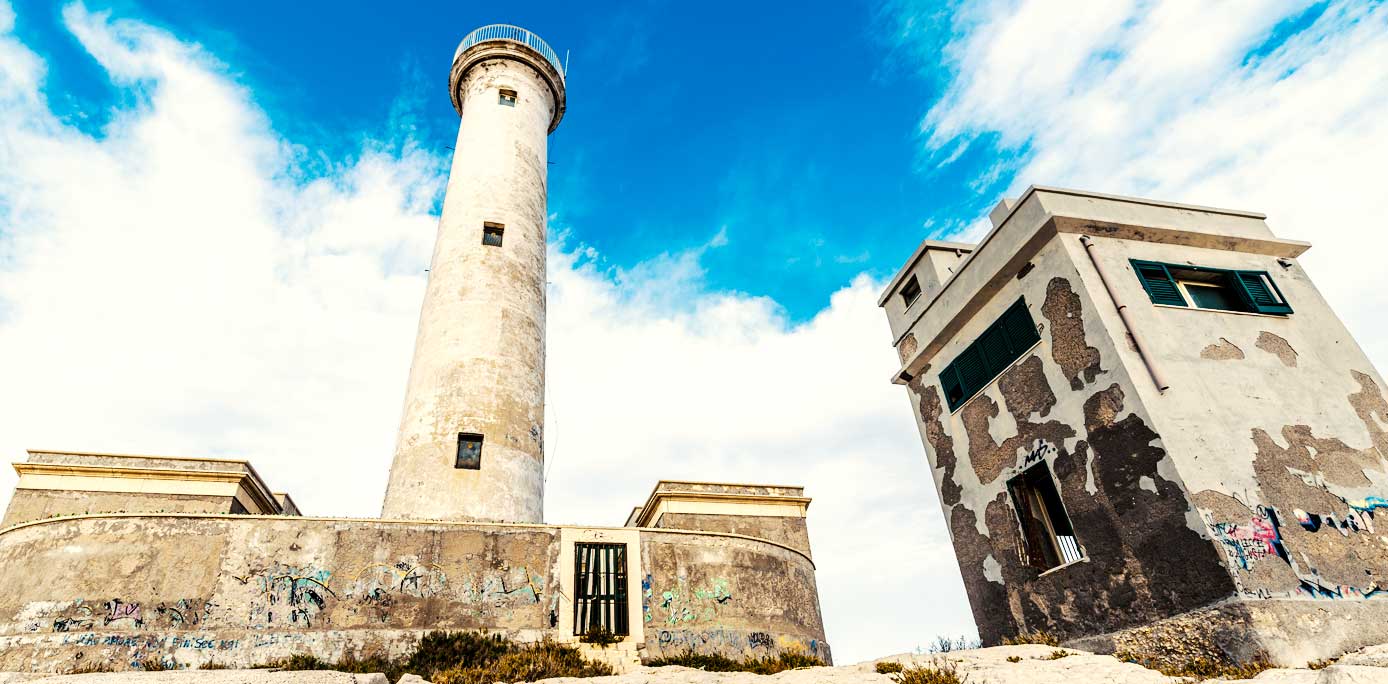There seems to be a shared fascination with lighthouses the world over. These austere pillars of hope and guidance, most often planted on precarious ground, seem to speak to our need to be watched over, protected, guided through life’s storms. Or maybe it’s just that they’re simply beautiful in their varied shapes, forms, and layouts. Whatever the draw, the fascination is real.
A quick history lesson tells us that burning heaps of heather and broom placed within watch towers served as the earliest Italian lighthouses for seafaring vessels. This somewhat effective but messy combination gave way during the 1300’s to true signal lamps that burned olive oil. Interestingly so, olive oil was used as fuel in Italian lighthouses until the end of the 19th century. One of the most famous – and still in operation – is Genoa’s Capo di Faro built in 1326, which is said to have been operated at one point by Christopher Columbus’s Uncle Antonio.
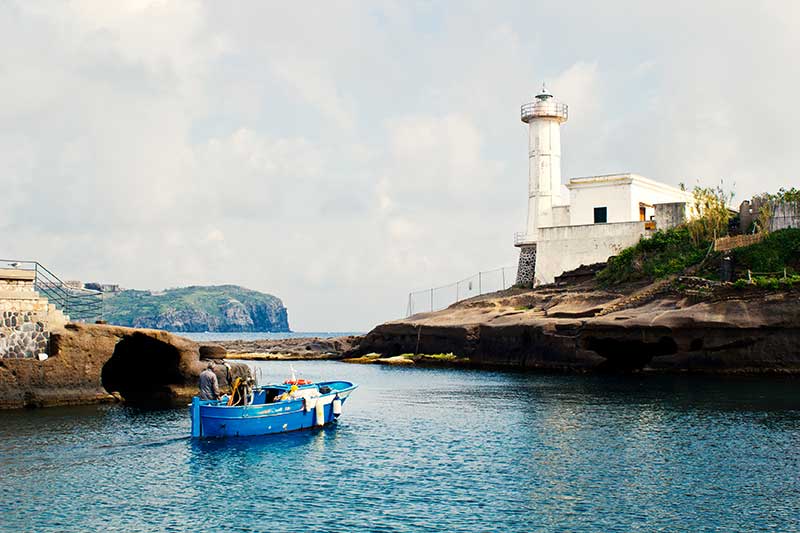
The lighthouse on Ventotene island, in Lazio (© Dreamstime)
Italy’s approximate 5,000 miles of coastline provide a roost to hundreds of lighthouses, the majority qualifying for old-age status. As many as 500 still patiently illuminate safe passage through precarious waters, yet many also sit abandoned to time…and lack of funding. Paired with the high number of lighthouses dotting the Italian coastline are the strapping costs of maintenance and restoration.
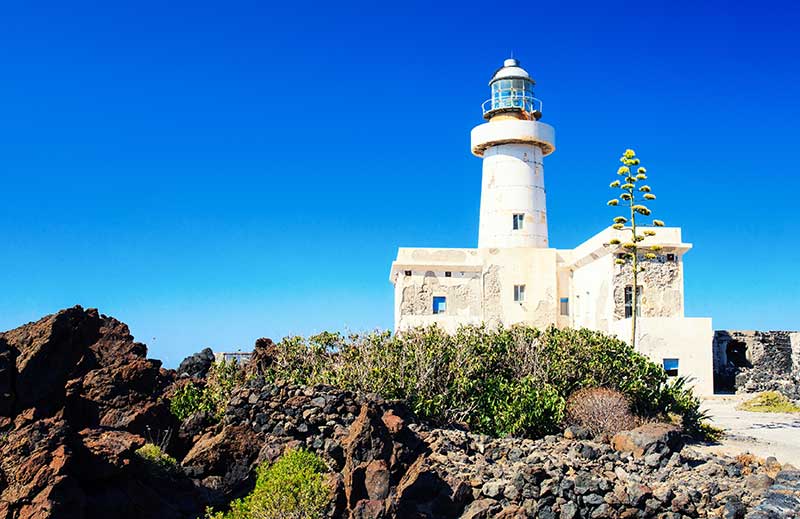
Much like the well-known “Buy a house for a Euro” promotions in numerous Italian villages as a means to protect and preserve cultural heritage, the Italian Agency for State Property (Agenzia del Demanio) initiated a similar program for lighthouse restoration called Valore Paese Faro – the Lighthouse Restoration Project. Modeled on the success of like-minded programs in countries such as Spain, Canada, and the USA, the project’s mission is “…the recovery and reuse of lighthouses and coastal buildings for tourism, cultural and social purposes, in line with the principles of sustainability linked to the culture of the sea.” And unquestionably the hoped-for bolus of tourist dollars.
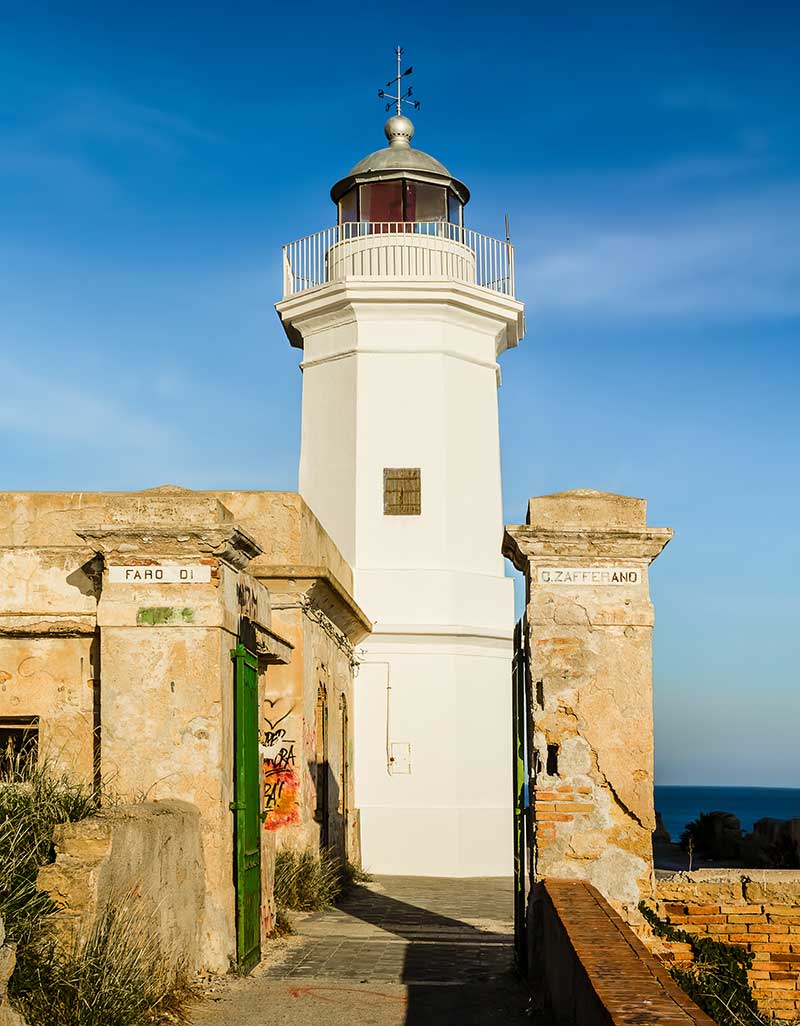
The lighthouse of Capo Zafferano: like many others it could become a beautiful tourist attraction (© Dreamstime)
The launch of the program in 2016 initialized with the commission for lease of 20 state-owned lighthouses located throughout Italy. Along with restoration, the program’s aim is to reduce government debt by off-loading to private investors, as well as encourage tourism in rural areas. Once a lease is obtained, however, the real investment begins.
The new proprietor must have experience in the tourism industry, as well as present a feasible plan for refurbishing the lighthouse towards use as a community and tourist attraction. Think lighthouse B&B, destination weddings, seaside café, and so on. A commission is then awarded for up to 50 years, along with the lessee’s agreement to maintain the historic integrity of the lighthouse throughout its renovation, as well as integrate sustainable and ecologically sound procedures and practices. Of course, the investor is also guaranteed some of the best of Italy’s waterfront property, views worthy of a coffee table book, and the promise of high profit returns. With an average lease commitment of $55,000 a year and the allure of yearly tax credits, it’s a tantalizing risk for both private and corporate investors alike.
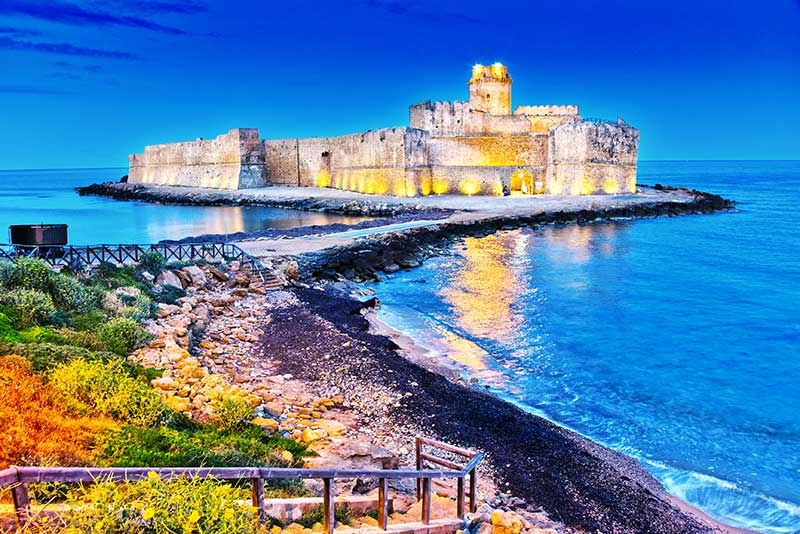
A scenic view of the Capo Rizzuto lighthouse (© Dreamstime)
What does the Italian government stand to gain, other than bringing new life to decaying but precious architectural history and shuffling off some debt? Initial figures at the inception of the program projected a long-term profit of eight billion euro – a hefty sum to go along with privatized revitalization of crumbling landmarks and increased tourism and employment. And where that profitability stands…or will ultimately end up…is yet to be seen.
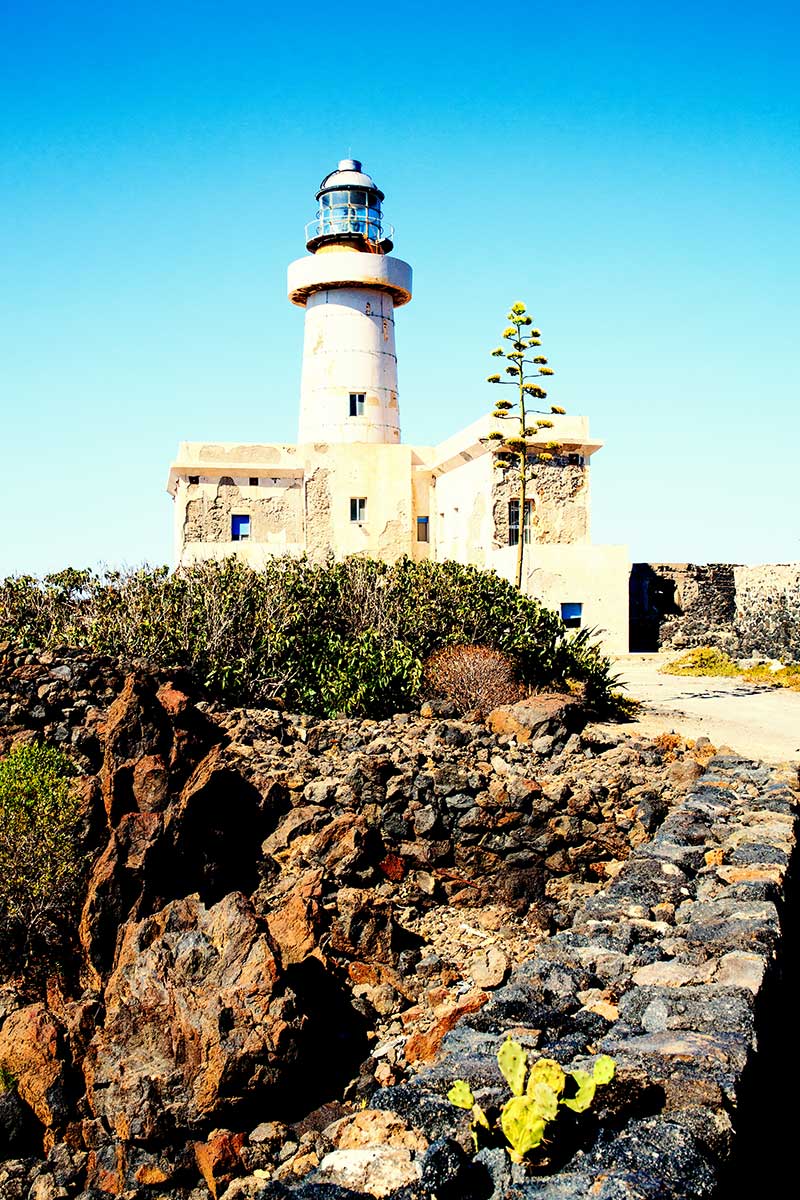
The lighthouse of the Sicilian island of Pantelleria (© Dreamstime)
However, it’s safe to say that progress does indeed continue to be made at the hands of this worthy project. The Agency for State Property annual report released in July of 2018 shows 29 coastal structures having been commissioned, with nine more to be released at the printing of the report. The outreach has extended to include additional coastal structures such as ancient towers, fortifications, villas, and other historically important buildings that are under the management of Italian Regions and Municipalities.
Whether all nine properties were commissioned won’t be revealed until the release of the 2019 report; however, the listings are alluring for anyone with dreams of preserving and caring for an extraordinary piece of Italian history. Up for grabs — the Fort of Castagneto Carducci, situated on a Tuscan Blue Flag beach and waiting to come to life as the best new beachside B&B in town. Prefer something quieter? It can be yours on the island of Elba where the white-washed Punta Polveraia Lighthouse overlooks an azure Ligurian sea, ripe for rebirth into a stunning retreat. These projects aren’t easy, but with steely vision, monumental patience, and good financial backing, a storybook ending is definitely realistic. Sardinia is home to one such example – The Hotel Faro Capo Spartivento. Constructed in 1854 on order of King Emmanuel II of Savoy, the lighthouse and surrounding buildings perched on a craggy Sardinian cliff were abandoned in the early 1980’s. An eight years long restoration project brought the once-regal naval structure back to life, even garnering praise from the Italian Navy as a prime example of military architectural restoration.
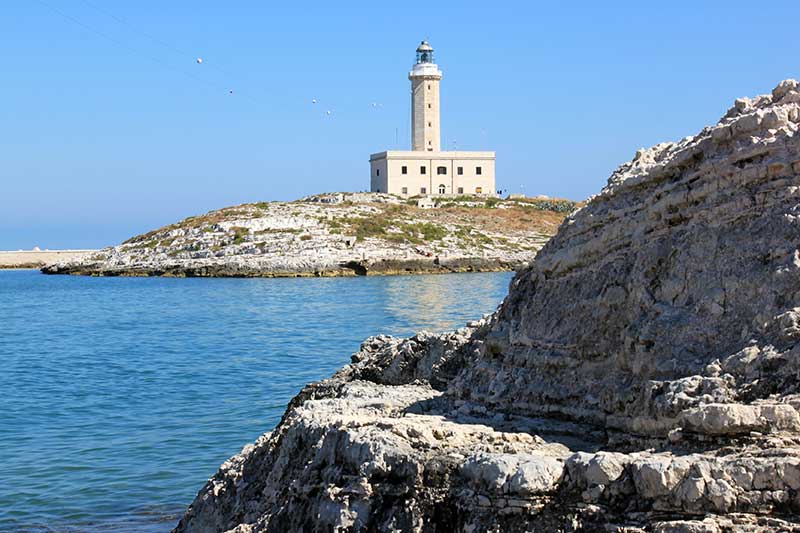
The Vieste lighthouse, in Puglia (© Dreamstime)
Following the mandates of the Lighthouse Restoration Project (Valore Paese Faro), Faro Capo Spartivento’s rejuvenation was accomplished with great respect to preservation of its original form, yet done with locally sourced materials and sustainable practices. Off-grid energy via solar panels provides power, while desalinated sea water fills the need for watering the grounds and other utilitarian purposes. The concept also includes, in addition to elegant hotel rooms, community friendly aspects such as wedding packages, creative retreats, team building experiences, and open access for photo shoots. From the images of this solitary retreat, it’s not hard to imagine time spent destressing to the songs of the gulls and hum of the sea breeze under a Sardinian sky!
Beacons of light, these grand old lighthouses are one by one being given the opportunity to shine anew thanks to the Italian Lighthouse Renovation Project. Economic gain is a piece of the puzzle, but more importantly these structures have the chance to remain a viable part of the Italian landscape, a visible testament to the seafaring communities they served, and a cultural link that would be regrettable to see slip away. Author Steve Berry says it well: “A concentrated effort to preserve our heritage is a vital link to our cultural, educational, aesthetic, inspirational, and economic legacies – of all the things that quite literally make us who we are.”
Sembra esserci un fascino condiviso nei fari di tutto il mondo. Questi austeri pilastri di speranza e di guida, il più delle volte piantati su terreni precari, sembrano parlare del nostro bisogno di essere sorvegliati, protetti, guidati attraverso le tempeste della vita. O, forse, è solo che sono semplicemente belli nelle loro varie forme, aspetto e layout. Qualunque sia il loro disegno, il fascino è reale.
Una rapida lezione di storia ci dice che i primi fari italiani per le imbarcazioni erano costituiti da cumuli di erica e ginestra accesi all’interno delle torri di guardia. Questa combinazione efficace ma un po’ casuale lasciò il posto, nel corso del 1300, a vere e proprie lampade di segnalazione che bruciavano olio d’oliva. È interessante notare che l’olio d’oliva sia stato utilizzato come combustibile nei fari italiani fino alla fine del XIX secolo. Uno dei più famosi – e ancora in funzione – è il Capo di Faro di Genova, costruito nel 1326, che si dice sia stato gestito ad un certo punto da Antonio, zio di Cristoforo Colombo.
Le circa 5.000 miglia di costa italiana sono sede di centinaia di fari, la maggior parte dei quali antichi. Ben 500 illuminano ancora pazientemente un passaggio sicuro attraverso acque precarie, molti altri sono stati abbandonati al tempo….e senza finanziamenti. Insieme all’elevato numero di fari che punteggiano la costa italiana, ci sono infatti i costi di manutenzione e restauro.
Proprio come le famose promozioni “Comprare una casa per un euro” in numerosi villaggi italiani, come mezzo per proteggere e preservare il patrimonio culturale, l’Agenzia del Demanio ha avviato un programma simile per il restauro dei fari, denominato Valore Paese Faro – il Progetto di restauro dei fari. Basato sul successo di programmi simili in paesi come la Spagna, il Canada e gli Stati Uniti, la missione del progetto è “….il recupero e il riutilizzo dei fari e degli edifici costieri a fini turistici, culturali e sociali, in linea con i principi di sostenibilità legati alla cultura del mare”. E, senza dubbio, all’auspicato ingresso di moneta turistica.
L’avvio del programma nel 2016 è stato siglato con la commissione per l’affitto di 20 fari di proprietà statale dislocati in tutta Italia. Insieme al restauro, l’obiettivo del programma è quello di ridurre il debito pubblico scaricandolo su investitori privati, oltre a favorire il turismo nelle aree rurali. Una volta ottenuta la locazione, tuttavia, inizia l’investimento reale.
Il nuovo proprietario deve avere esperienza nel settore turistico, oltre a presentare un piano fattibile per la ristrutturazione del faro per utilizzarlo come attrazione comunitaria e turistica. Pensate a B&B, location per matrimoni, caffè sul mare, e così via dentro un faro. Una commissione viene poi assegnata per un massimo di 50 anni, insieme all’accordo del locatario a mantenere l’integrità storica del faro durante tutta la sua ristrutturazione, oltre a prevedere procedure e pratiche sostenibili ed ecologicamente valide. Naturalmente, all’investitore sono garantiti alcuni dei migliori immobili sul lungomare italiano, panorami degni di un libro illustrato e la promessa di alti profitti. Con un impegno medio di locazione di 55.000 dollari all’anno e l’attrattività dei crediti d’imposta annuali, è un investimento allettante sia per gli investitori privati che per quelli aziendal.
Che cosa ci guadagna il governo italiano, oltre a dare nuova vita alla decadente ma preziosa storia dell’architettura e a cancellare qualche debito? Le cifre iniziali, all’avvio del programma, prevedevano un utile a lungo termine di otto miliardi di euro – una somma cospicua che andava di pari passo con la privatizzazione del processo di rivitalizzazione di monumenti fatiscenti e l’aumento del turismo e dell’occupazione. Staremo a vedere dove si genererà quella redditività ….o dove andrà a finire.
Tuttavia, si può dire con sicurezza che i progressi continuano ad essere fatti attraverso questo progetto meritevole. Il rapporto annuale dell’Agenzia per il Demanio dello Stato pubblicato nel luglio 2018 mostra che 29 strutture costiere sono state assegnate, mentre altre nove saranno assegnate al momento della pubblicazione del rapporto. Il raggio d’azione si è esteso ad altre strutture costiere come antiche torri, fortificazioni, ville e altri edifici di importanza storica che sono sotto la gestione delle Regioni e dei Comuni italiani.
Se tutte e nove le proprietà saranno state assegnate, sarà rivelato all’uscita del rapporto del 2019; tuttavia, gli elenchi sono allettanti per chiunque abbia il sogno di conservare e prendersi cura di un pezzo straordinario di storia italiana.
In palio ci sono: il Forte di Castagneto Carducci, situato su una spiaggia Bandiera Blu della Toscana e in attesa di prendere vita come il miglior nuovo B&B sulla spiaggia della città. Preferite qualcosa di più tranquillo? Potrete averlo sull’Isola d’Elba, dove il bianco faro di Punta Polveraia si affaccia sull’azzurro mare ligure, pronto per rinascere come rifugio mozzafiato.
Questi progetti non sono facili, ma con una visione d’acciaio, pazienza monumentale e un buon sostegno finanziario, un finale da favola è sicuramente realistico.
La Sardegna è la patria di uno di questi esempi: l’Hotel Faro Capo Spartivento. Costruito nel 1854 per ordine del re Emanuele II di Savoia, il faro e gli edifici circostanti, arroccati su una scoscesa scogliera sarda, furono abbandonati nei primi anni ‘80. Un progetto di restauro durato otto anni ha riportato in vita l’antica struttura navale reale, ottenendo anche gli elogi della Marina Militare Italiana, in quanto primo esempio di restauro architettonico militare.
Su mandato del Progetto di Restauro del Faro (Valore Paese Faro), il restauro del Faro Capo Spartivento è stato realizzato nel pieno rispetto della conservazione della sua forma originale, con materiali di provenienza locale e pratiche sostenibili. L’energia viene prodotta attraverso pannelli solari, mentre l’acqua di mare desalinizzata copre la necessità di irrigazione del terreno e altri scopi utilitaristici. Il concetto include, oltre alle eleganti camere d’albergo, impieghi comunitari come pacchetti per matrimoni, ritiri creativi, esperienze di team building e accesso aperto ai servizi fotografici. Dalle immagini di questo rifugio solitario, non è difficile immaginare il tempo passato a disintossicarsi tra i canti dei gabbiani e il ronzio della brezza marina sotto il cielo sardo!
Fari di luce: questi grandi vecchi fari hanno tutti l’opportunità di brillare di nuovo grazie al Progetto di Ristrutturazione dei fari italiani. Il guadagno economico è un pezzo del puzzle, ma la cosa più importante è che queste strutture hanno la possibilità di rimanere una parte vitale del paesaggio italiano, una testimonianza visibile delle comunità marinare che hanno servito, e un legame culturale che sarebbe deplorevole vedere scivolare via.
Lo dice bene l’autore Steve Berry: “Uno sforzo concentrato per preservare il nostro patrimonio è un legame vitale con il nostro patrimonio culturale, educativo, estetico, motivazionale ed economico – con tutte le cose che ci rendono letteralmente ciò che siamo”.






